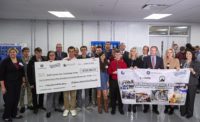Stronger than expected growth in the manufacturing sector, as well as increased consumer confidence heading into vacation season, are likely behind the busier summer hiring season. Employers in the following industries are expected to lead seasonal hiring:
"Confidence is up among the employers we most closely associate with summer hiring,” says Brent Rasmussen, president of CareerBuilder North America. “This is good news for job seekers, as seasonal work can often lead to full-time opportunities. A majority of employers told us they consider a summer position an extended job interview. The forecast is also a strong indicator that the job market will continue to strengthen as we come closer to the second half of 2012."
The possibility of full-time employment makes summer work a good opportunity for recent college grads, unemployed job seekers, and people who've left the workforce altogether. Seventy-one percent of employers hiring this summer said they'll be considering some hires for permanent positions. In fact, 39% of employers said they're less likely to hire someone who isn't interested in working beyond summer.
A majority (64%) of employers will pay their summer hires $10 or more per hour – up from 58 percent last year. Twenty percent will pay more than $16 per hour; 29% will pay $8 to $10.
While 42% of employers report that they typically complete their summer hiring by April, 38 percent complete it in May and 19% will hire in June and beyond.
It's not just retail, hospitality and manufacturing jobs available this summer. Employers also plan to hire seasonal help in the following areas: customer service, office support, information technology, research, engineering and sales.
This survey was conducted online within the U.S. by Harris Interactive on behalf of CareerBuilder among 2,303 hiring managers and human resource professionals (employed full-time, not self-employed, non-government) between February 9 and March 2, 2012 (percentages for some questions are based on a subset, based on their responses to certain questions). With a pure probability sample of 2,303, one could say with a 95% probability that the overall results have a sampling error of +/- 2.04 percentage points. Sampling error for data from sub-samples is higher and varies.




